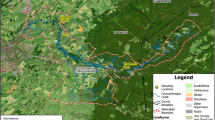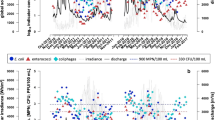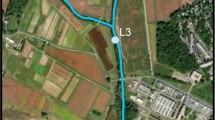Abstract
The Charlotte Harbor estuary in southwest Florida was sampled monthly for one year at twelve stations, in the lower reaches of the Myakka and Peace Rivers. The objectives of the study were to address the distribution and seasonal changes in microbial indicators and human pathogen levels in Charlotte Harbor shellfish and recreational waters, and to determine those factors that may be important in the transport and survival of pathogens. Monthly water samples and quarterly sediment samples were analyzed for fecal coliform bacteria, enterococci,Clostridium perfringens, and coliphage. Quarterly samples also were analyzed for the enteric human pathogens,Cryptosporidium spp.,Giardia spp., and enteroviruses. Fecal indicator organisms were generally concentrated in areas of low salinity and high densities of septic systems; however, pollution became widespread during wet weather in, the late fall and winter of 1997–1998, coincident with a strong El Nino event. Between, December 1997 and February 1998, enteroviruses were detected at 75% of the sampling stations; none were detected in other months. Enteric protozoa were detected infrequently and were not related to seasonal influences. Fecal indicators and enteroviruses were each significantly associated with rainfall, streamflow, and temperature. Regression models suggest that temperature and rainfall can predict the occurrence of enteroviruses in 93.7% of the cases. Based on findings in this watershed, factors such as variability in precipitation, streamflow, and temperature show promise in modeling and forecasting periods of poor coastal water quality.
Similar content being viewed by others
Literature Cited
Adams, M. H. 1959. Bacteriophages. Interscience Publications, New York.
American Public Health Association. 1992. Standard Methods for the Evaluation of Water and Wastewater. 18th edition, Washington, d.C.
Anderson, D. L., A. L. Lewis, andK. M. Sherman. 1991. Human enterovirus monitoring at onsite sewage disposal systems in Florida, p. 62–76.In Onsite Wastewater Treatment, Volume 6. Proceedings, of the 6th National Symposium on Individual and Small Community Sewage Systems. American Society of Agricultural Engineers, Chicago, Illinois.
Bicki, T. J. andR. B. Brown. 1990 Onsite sewage disposal.Journal of Environmental Health 53:39–42.
Bisson, J. W. andV. J. Cabelli. 1979. Membrane filtration enumeration method forClostridium perfringens.Applied and Environmental Microbiology 37:55–66.
Ellender, R. D., J. B. Mapp, B. L. Middlebrooks, D. W. Cook, andE. W. Cake. 1980. Natural enterovirus and fecal coliform contamination of Gulf Coast oysters.Journal of Food Protection 43:105–110.
El-Sharkawi, F., L. El-Atar, A. A. Gawad, andS. Molazern. 1989. Some environmental factors affecting the survival of fecal pathogens and indicator organisms in seawater.Water Science and Technology 21:115–120.
Fayer, R., C. A. Farley, E. J. Lewis, J. M. Trout, andT. K. Graczyk. 1997. Potential role of the Eastern Oyster,Crassostrea virginica, in the epidemiology ofCryptosporidium parvum.Applied and Environmental Microbiology 63:2086–2088.
Fattal, B., R. J. Vasl, E. Katznelson, andH. I. Shuval. 1983. Survival of bacterial indicator organisms and enteric viruses in the Mediterranean coastal waters off Tel-Aviv.Water Research 17:397–402.
Ferguson, C. M., B. G. Coote, N. J. Ashbolt, andI. M. Stevenson. 1996. Relationships between indicators, pathogens and water quality in an estuarine system.Water Research 30:2045–2054.
Florida Department of Environmental Protection. 1996a. Florida Water Quality Assessment, 305 (b) Main Report. Florida Department of Environmental Protection, Tallahassee, Florida.
Florida Department of Environmental Protection. 1996b. Criteria for Surface Water Classification Ch. 62-302.530. Tallahassee, Florida.
Fujioka, R. S. andL. K. Shizumura. 1985.Clostridium perfringens, a reliable indicator of stream water quality.Journal of the Water Pollution Control Federation 57:986–992.
Gerba, C. P. andJ. S. McLeod. 1976. Effect of sediments on the survival ofEscherichia coli in marine waters.Applied and Environmental Microbiology 32:114–120.
Goyal, S. M., C. P. Gerba, andJ. L. Melnick. 1978. Prevalence of human enteric viruses in coastal canal communities.Journal of the Water Pollution Control Federation 50:2247–2257.
Goyal, S. M., C. P. Gerba, andJ. L. Melnick. 1979. Human enteroviruses in oysters and their overlying waters.Applied and Environmental Microbiology 37:572–581.
Gueri, M. C. Gonzalez, andV. Morin. 1986. The effect of the floods caused by “El Niño” on health.Disasters 10:118–124.
Hosmer, D. W. andS. Lemeshow. 1989. Applied Logistic Regression. Wiley, New York.
Jaykus, L.-A, M. T. Hemard, andM. D. Sobsey. 1994. Human enteric pathogenic viruses, p. 92–153.In C. R. Hackney and M. D. Pierson (eds.), Environmental Indicators and Shellfish Safety. Chapman and Hall, New York.
Johnson, D. C., C. E. Enriquez, I. L. Pepper, T. L. Davis, C. P. Gerba, andJ. B. Rose. 1997. Survival ofGiardia, Cryptosporidium, poliovirus andSalmonella in marine waters.Water Science and Technology 35:261–268.
Kurz, R. C. 1998. Removal of Microbial Indicators from Storm-water Using Sand Filtration, Wet Detention, and Alum Treatment Best Management Practices. Technical Report. Southwest Florida Water Management District, Tampa, Florida.
LaPointe, B. E., J. D. O'Connell, andG. S. Garrett. 1990. Nutrient couplings between on-site waste disposal systems, groundwaters and nearshore surface waters of the Florida Keys.Biogeochemistry 10:289–307.
Lipp, E. K., S. R. Farrah, andJ. B. Rose. 2001. Assessment and impact of microbial fecal pollution and human enteric pathogens in a coastal community.Marine Pollution Bulletin 24:286–293.
Lipp, E. K. andJ. B. Rose. 1997. The role of seafood in foodborne diseases in the United States of America.Revue Scientifique et Technicale. Office Internationale des Epizoolies 16:620–640.
Lipp, E. K., N. Schmidt, M. Luther, and J. B. Rose. In Press. Determining the effects of El Niño-Southern Oscillation events on coastal water quality.Estuaries.
National Research Council. 1993. Managing Wastewater in Coastal Urban Areas. Committee on Wastewater Management for Coastal Urban Areas, Water Science and Technology Board, Commission on Engineering and Technical Systems. National Academy Press, Washington, D.C.
Paul, J. H., J. B. Rose, J. Brown, E. Shinn, S. Miller, andS. Farrah. 1995. Viral tracer studies indicate contamination of marine waters be sewage disposal practices in Key Largo, Florida.Applied and Environmental Microbiology 61:2230–2234.
Paul, J. H., J. B. Rose, S. Jiang, X. Zhou, P. Cochran, C. Kellog, J. B. Kang, D. Griffin, S. Farrah, andJ. Lukasik. 1997. Evidence for groundwater and surface marine water contamination by waste disposal wells in the Florida Keys.Water Research 31:1448–1454.
Ropelewski, C. F. andM. S. Halpert. 1986. North American precipitation and temperature patterns associated with El Niño/Southern Oscillation (ENSO).Monthly Weather Review 114:2352–2362.
Scalf, M. R., W. J. Dunlap, and J. F. Kreissel. 1977. Environmental Effects of Septic Tank Systems. U.S. Environmental Protection Agency 18, EPA-600/3-77-096. Ada, Oklahoma.
Schmidt, N., E. K. Lipp, J. B. Rose, andM. E. Luther. 2001. Analysis of ENSO related trends in Florida precipitation and streamflow.Journal of Climate 14:615–628.
Solic, M. andN. Krstuvolic. 1992. Separate and combined effects of solar radiation, temperature, salinity and pH on the survival of fecal coliforms in seawater.Marine Pollution Bulletin 24:411–416.
Southwest Florida Water Management District. 1993. Charlotte Harbor Surface Water Improvement Management Plan. Southwest Florida Water Management District Technical Report. Tampa, Florida.
Sun, H. andD. J. Furbish. 1997. Annual precipitation and river discharges in Florida in response to El Niño and La Niña sea surface temperature anomalies.Journal of Hydrology 199:74–87.
U.S. Environmental Protection Agency. 1986. Ambient Water Quality Criteria for Bacteria. Environmental Protection Agency 440/5-84-002. Washington, D.C.
U.S. Environmental Protection Agency. 1994. Monitoring Requirements for Public Drinking Water Supplies: Proposed Rule. Federal Register 59(28). Cinncinatti, Ohio.
U. S. Environmental Protection Agency. 1997. National Water Quality Inventory: 1996 Report to Congress. EPA841-R-97-008. Cinncinatti, Ohio.
Weiskel, P. K., B. L. Howes, andG. R. Heufelder. 1996. Coliform contamination of a coastal embayment: Sources and transport pathways.Environmental Science and Technology 30:1872–1881.
Wyer, M. D., D. Kay, G. F. Jackson, H. M. Dawson, J. Yeo, andL. Tanguy. 1995. Indicator organism sources and coastal water quality: A catchment study on the Isle of Jersey.Journal of Applied Bacteriology 78:290–296.
Zorn, M. R. andP. R. Waylen. 1997. Seasonal response of mean monthly streamflow to El Niño/Southern Oscillation in north central Florida.Professional Geographer 49:51–62.
Sources of Unpublished Materials
Florida Department of Environmental Protection. Unpublished data. 1481-B Market Circle, Port Charlotte, Florida 33953.
Peace River Water Supply. Unpublished data 8998 Southwest County Road 769, Arcadia, Florida 34266.
Southwest Florida Water Management District. Unpublished data. 2379 Broad Street, Brooksville, Florida 34604-6899.
U.S. Geological Survey. Unpublished data. 4710 Eisenhower Boulevard, Suite B-5, Tampa, Florida 33634.
Author information
Authors and Affiliations
Corresponding author
Rights and permissions
About this article
Cite this article
Lipp, E.K., Kurz, R., Vincent, R. et al. The effects of seasonal variability and weather on microbial fecal pollution and enteric pathogens in a subtropical estuary. Estuaries 24, 266–276 (2001). https://doi.org/10.2307/1352950
Received:
Accepted:
Issue Date:
DOI: https://doi.org/10.2307/1352950




